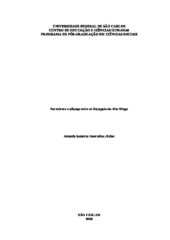Parentesco e aliança entre os Kalapalo do Alto Xingu

Visualizar/
Data
2008-03-04Autor
Guerreiro Júnior, Antonio Roberto
Metadata
Mostrar registro completoResumo
The main aim of this paper is to describe and analyze the marriage alliance system of
the Kalapalo, a karib-speaking group from Alto Xingu (MT), by means of a critical review of
the available hypothesis on the xinguan kinship and the presentation of newer ethnographical
data on alliance in relation to the presently available ones in the anthropological literature
about the region. Such data allow to identify the types of existing unions and its respective
statistical trends, subsidizing the test of the current hypotheses on the forms of transmission
and production of affinity in upper-xinguan systems in the ethnographical context of the
kalapalo system. Still, one becomes able to question about the real reach and also the limits of
the hypothesis on the alliance structure of the peoples of the region to be of the
(patri)multibilateral type, therefore the data disclose the existence of an ideal and a strong
trend among the Kalapalo for the matrilateral marriage. Considering that the matrilateral
exchange is not a common fact in indigenous Amazonia, where variations of the patrilateral
marriage prevail, this characteristic of the kalapalo system leads us to question the
multibilateral model considered for the upper-xinguan systems, and becomes a basic problem
to investigate how these different structures combine in one same system. For that, a
diachronical analysis of some alliance nets will be made, considering the conditions of
production and redoubling of unions as well as the coexistence of two exchange structures
(one patri and another matrilateral), what will lead to a definition of the kalapalo system as
"complex" and to the association of the matrilateral marriages with the institution of
chieftaincy.